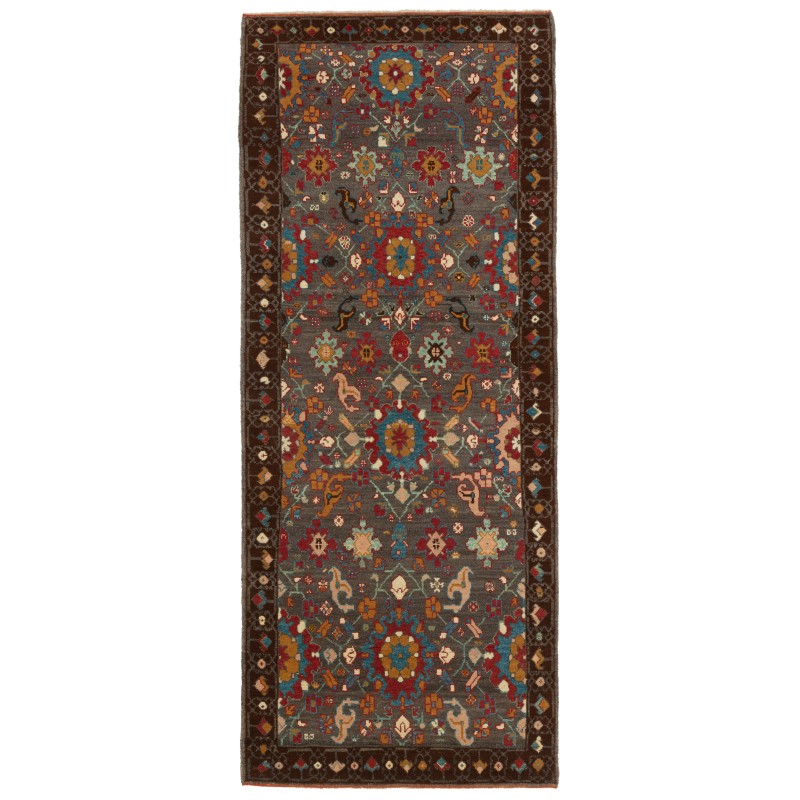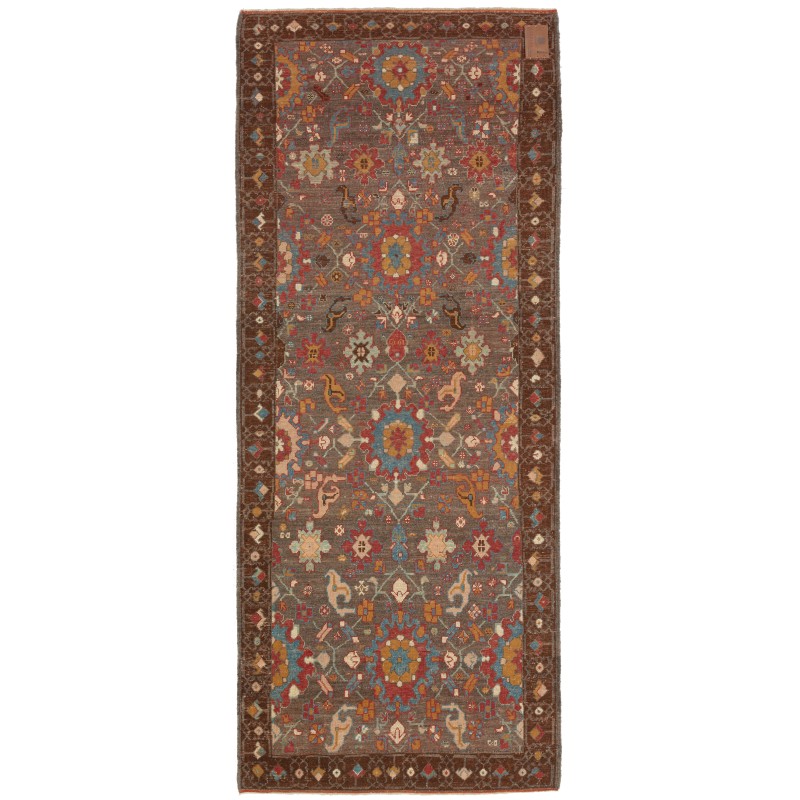



- Stock: In Stock
- Model: C50544
- サイズ: 210cm x 86cm
- Weight: 5.90kg
- SKU: ART544
このオフセットパターンは、パルメットと花で構成されており、それは19世紀のビジャール地域、東クルディスタン地域のデザインの一部であるかのような印象を与えます。非常に似たようなパルメットが、ヘラートのホラサン州で17世紀末から作られたワークショップの絨毯の一部にも見られ、同じパターンは18世紀のコーカサスでも使用されました。このデザインには、鮮やかな色のパルメットと花の豪華な繰り返しの配列が使用されており、それは17世紀の大型花瓶技法の絨毯の直系の子孫としてそれを特徴付けています。
クルディスタンは、デザインや豊かな鮮やかな色の点で優れた絨毯を生み出した地域として、おそらく初期から19世紀までにかけて広く認識されていない場所です。技術的には、19世紀の頑丈で重い二重経糸のビジャールから、このような柔軟な絨毯やきめの細かいキリムまでさまざまです。この例に表示されているデザインは、明らかに17世紀のモデルに由来しており、その人気が高まり、東部ペルシャだけでなくコーカサスにも広がりました。18世紀に続き、19世紀のコーカサスの絨毯でも見ることができます。この絨毯のデザインは、二つの大きな横方向のパルメットに小さなパルメットの花が囲むという交互の連続で構成されており、中央の丸い花のメダリオン、このロゼットを向かい合わせる2つの異なるデザインの大きなパルメット形状の4つ、および斜め軸上のロゼットで満たされた4つのダイヤモンド状カルトゥーシュからなる複雑なパルメット配置です。背景のフィールドは、小規模の格子状システムで埋められています。ボーダーデザインは、カルトゥーシュとスターメダリオンの連続する伝統に沿っています。両方のガードストライプは、生き生きとした角度のある葉っぱのメアンダースクロールで埋められています。格子状のデザインは無限に続いているように見えます - ビジャールのフレームで囲まれたセクションを見ることができるかのように。絨毯のデザインはデザイナーによって解釈され、柔らかな色がこの絨毯に選ばれています。
This offset pattern is composed of palmettes and flowers, one has the impression that it is only part of a larger scheme designed 19th-century rug from the Bidjar region, Eastern Kurdistan area. Very similar palmettes, drawn in a curvilinear manner and combined with identical forked leaves, can be seen on a few examples of workshop carpets made from the late seventeenth century onward in Herat in Khurasan province, east Persia, and the same pattern known as Harshang design was used in the Caucasus in the eighteenth century, as well. The design employs floral, richly complex repeating arrays of brilliant color palmettes and flowers that mark it as a lineal descendant of the great vase-technique carpets of the seventeenth century.
Kurdistan has not usually been given it’s due as a region that has produced rugs of considerable excellence in design and rich brilliant colors, probably from early times on, well into the 19th century. Technically they range from the solid, heavy, double-warped Bijars of the 19th century to the flexible rug of this type, and the Kilims, or flat-woven rugs of great delicacy. The design displayed in this example, clearly derived from a 17th-century model, proved so popular that it spread not only to Eastern Persia but to the Caucasus as well. It continues well into the 18th century and can still be found in Caucasian rugs of the 19th century. The design of this rug is based on an alternating succession of two large lateral palmettes surrounded by small palmette blossoms, a complex palmette arrangement composed of a central round floral medallion, four large palmette forms of two different designs facing this rosette, and four diamond-shaped cartouches, filled with rosettes, on the diagonal axis. A small-scaled trellis system fills, as a secondary pattern, most of the background of the field. The border design follows a well-established tradition of the cartouche and star medallion succession. Both guard stripes are filled with a lively angular leafy meander scroll. The lattice appears to continue into infinity – as though we can see the section that is framed by the Bidjar border. The design of the rug is interpreted by our designers, and soft colors are chosen for this rug.
私たちが作ったオリジナルの絨毯です。昔の作り方、染め方全て守って明日のアンティーク絨毯を眼材しています。 この絨毯作るのに全部で 9 色使っています。
- Rare Grey 105 (羊そのままの色)
- Natural Wool Color 37 (羊そのままの色)
- Carrissma 161 (コチニール)
- Cadet Blue 26 (トウダイグサ - 藍)
- Sunray Color 405 (ヘナ)
- Moss Green 27 (トウダイグサ - 藍)
- Burlywood 135 (トウダイグサ - 茜)
- Natural Wool Color 320 (羊そのままの色)
上の番号は私たちのカラーコードです。()の中は、主な草木染めの材料です。
